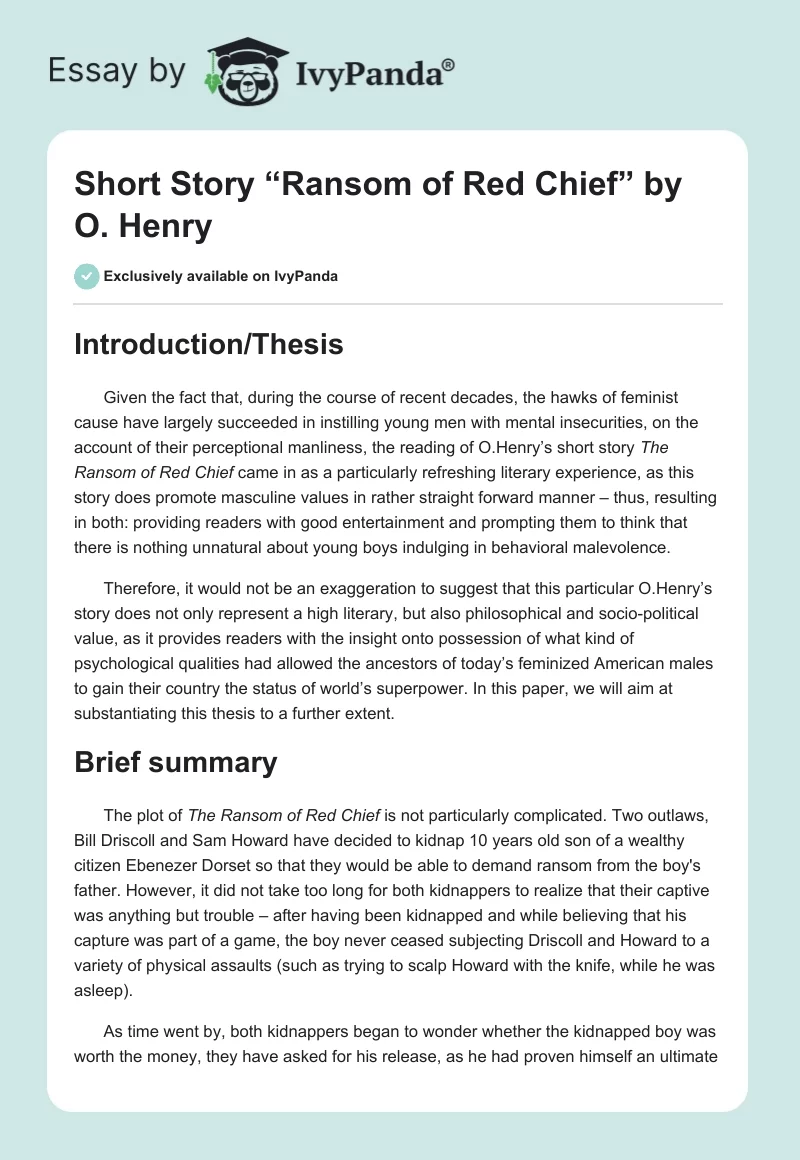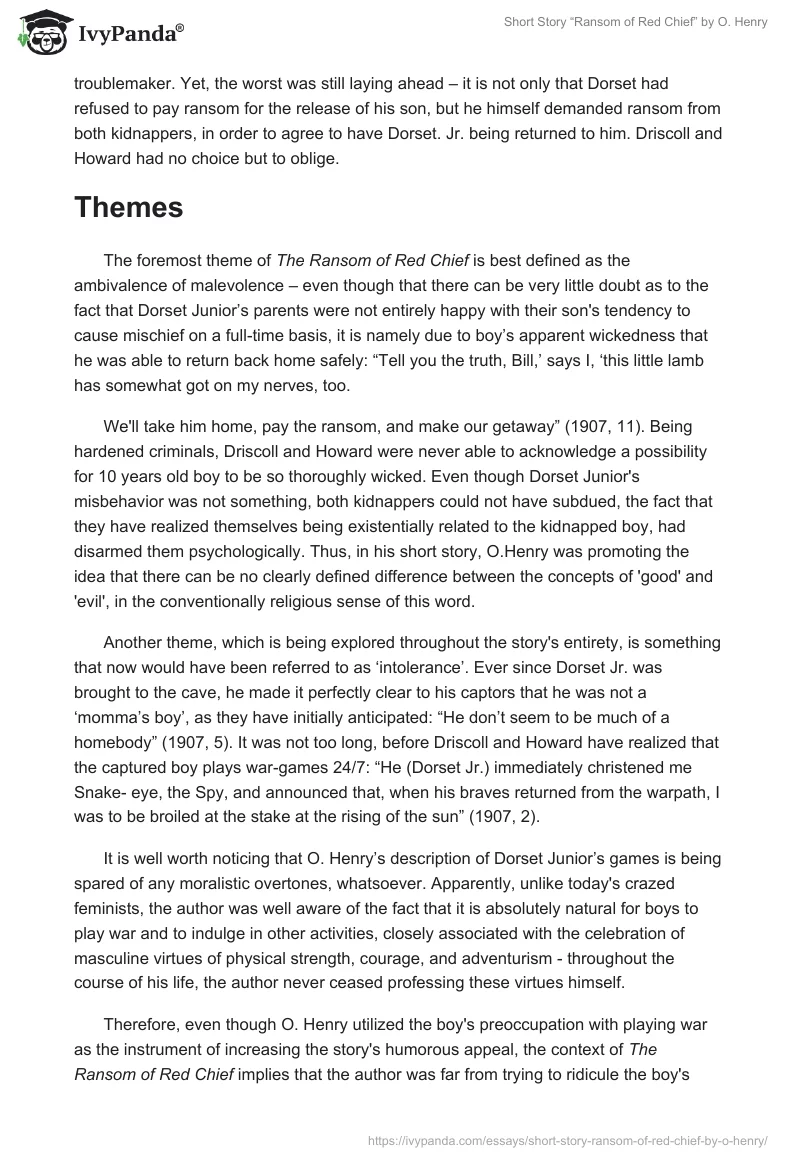Introduction/Thesis
Given the fact that, during the course of recent decades, the hawks of feminist cause have largely succeeded in instilling young men with mental insecurities, on the account of their perceptional manliness, the reading of O.Henry’s short story The Ransom of Red Chief came in as a particularly refreshing literary experience, as this story does promote masculine values in rather straight forward manner – thus, resulting in both: providing readers with good entertainment and prompting them to think that there is nothing unnatural about young boys indulging in behavioral malevolence.
Therefore, it would not be an exaggeration to suggest that this particular O.Henry’s story does not only represent a high literary, but also philosophical and socio-political value, as it provides readers with the insight onto possession of what kind of psychological qualities had allowed the ancestors of today’s feminized American males to gain their country the status of world’s superpower. In this paper, we will aim at substantiating this thesis to a further extent.
Brief summary
The plot of The Ransom of Red Chief is not particularly complicated. Two outlaws, Bill Driscoll and Sam Howard have decided to kidnap 10 years old son of a wealthy citizen Ebenezer Dorset so that they would be able to demand ransom from the boy’s father. However, it did not take too long for both kidnappers to realize that their captive was anything but trouble – after having been kidnapped and while believing that his capture was part of a game, the boy never ceased subjecting Driscoll and Howard to a variety of physical assaults (such as trying to scalp Howard with the knife, while he was asleep).
As time went by, both kidnappers began to wonder whether the kidnapped boy was worth the money, they have asked for his release, as he had proven himself an ultimate troublemaker. Yet, the worst was still laying ahead – it is not only that Dorset had refused to pay ransom for the release of his son, but he himself demanded ransom from both kidnappers, in order to agree to have Dorset. Jr. being returned to him. Driscoll and Howard had no choice but to oblige.
Themes
The foremost theme of The Ransom of Red Chief is best defined as the ambivalence of malevolence – even though that there can be very little doubt as to the fact that Dorset Junior’s parents were not entirely happy with their son’s tendency to cause mischief on a full-time basis, it is namely due to boy’s apparent wickedness that he was able to return back home safely: “Tell you the truth, Bill,’ says I, ‘this little lamb has somewhat got on my nerves, too.
We’ll take him home, pay the ransom, and make our getaway” (1907, 11). Being hardened criminals, Driscoll and Howard were never able to acknowledge a possibility for 10 years old boy to be so thoroughly wicked. Even though Dorset Junior’s misbehavior was not something, both kidnappers could not have subdued, the fact that they have realized themselves being existentially related to the kidnapped boy, had disarmed them psychologically. Thus, in his short story, O.Henry was promoting the idea that there can be no clearly defined difference between the concepts of ‘good’ and ‘evil’, in the conventionally religious sense of this word.
Another theme, which is being explored throughout the story’s entirety, is something that now would have been referred to as ‘intolerance’. Ever since Dorset Jr. was brought to the cave, he made it perfectly clear to his captors that he was not a ‘momma’s boy’, as they have initially anticipated: “He don’t seem to be much of a homebody” (1907, 5). It was not too long, before Driscoll and Howard have realized that the captured boy plays war-games 24/7: “He (Dorset Jr.) immediately christened me Snake- eye, the Spy, and announced that, when his braves returned from the warpath, I was to be broiled at the stake at the rising of the sun” (1907, 2).
It is well worth noticing that O. Henry’s description of Dorset Junior’s games is being spared of any moralistic overtones, whatsoever. Apparently, unlike today’s crazed feminists, the author was well aware of the fact that it is absolutely natural for boys to play war and to indulge in other activities, closely associated with the celebration of masculine virtues of physical strength, courage, and adventurism – throughout the course of his life, the author never ceased professing these virtues himself.
Therefore, even though O. Henry utilized the boy’s preoccupation with playing war as the instrument of increasing the story’s humorous appeal, the context of The Ransom of Red Chief implies that the author was far from trying to ridicule the boy’s existential militarism as ‘thing in itself’. Just as it was the case with handfuls of European explorers, which during the course of Era of Exploration had managed to impose their unilateral rule upon vast empires of Incas and Mayas, Dorset Jr. was only willing to appreciate emanations of surrounding reality for as long as he could turn them into a trophy: “We got him to go by telling him that his father had bought a silver-mounted rifle and a pair of moccasins for him, and we were to hunt bears the next day” (1907, 11).
Thus, despite the overall humorous sounding of O. Henry’s story, it does promote an utterly serious idea that, in order for a man to be able to attain social prominence, he would have to be indulging in manly activities, since very early in his life – thus, attaining an insight onto the true nature of things.
The third prominent theme of The Ransom of Red Chief (male bonding) cannot be discussed outside of the fact that, in the early 20th century, American society was ethnically homogeneous. As the novel’s context implies, despite being rather immoral individuals, Driscoll and Howard could not have possibly caused Dorset Jr. any harm, whatsoever. The reason for this is simple – they related to him racially, spiritually, and mentally.
In ethnically homogeneous European countries, such as Poland, Ukraine, or Iceland, people can leave their unsupervised small children playing in public places for hours, with the thought that these kids may be harmed never even occurring to the parents. In today’s multicultural America, however, once a small child has been left unattended for as little as one minute, there would be a good chance for this kid to become physically or even sexually abused.
As Sean Lee had put it in his review-article The Ransom of Red Chief Short Story by O. Henry: “The lesser evil portrayed by the Two Desperate Men is almost iconic, but should be called comical and foolish in today’s context. Given many authors, they will just kill the kid, dump the body, and move on to more sinister plans. That will keep the readers’ attention” (2008). Thus, the theme of male bonding, clearly present in O. Henry’s short story, appears being dialectically predetermined – one of the main reasons why The Ransom of Red Chief became instantly popular with O.Henry’s contemporaries, is that they found it realistic.
Writing style and symbols
O. Henry’s writing style in analyzed short story is best described as geographically authentic and spontaneous at the same time. Given the fact that story’s action takes place in Alabama, following the Reconstruction period, author had made a point in endowing his characters with an unmistakably Southern speech: “We’re dealing with humans, and it ain’t human for anybody to give up two thousand dollars for that forty-pound chunk of freckled wild cat” (1907, 7).
By being exposed to the dialogues that take place between characters, readers are able to confirm story’s realistic subtleties to themselves. Moreover, given the fact that protagonist Sam Howard’s attitudes seem to reflect O.Henry’s own outlook on the concept of ‘victimless crime’, it also would not be an exaggeration to refer to story’s writing style as essentially autobiographical.
Due to story’s narrative format, it would be naïve to expect The Ransom of Red Chief to contain a fair amount of symbolism. Nevertheless, a certain symbolism can still be found in it – namely, the recurring mentioning of a cave: “About two miles from Summit was a little mountain, covered with a dense cedar brake. On the rear elevation of this mountain was a cave” (1907, 1).
The symbolic meaning of cave can be interpreted as follows: cave is the ultimate hiding place, which implies that people endowed with militaristic mentality would be naturally attracted to it. The reason for it is simple – unlike civilians, natural-born-soldiers (by which we refer to the workings of one’s mind), subconsciously strive to conceal their presence in the particular terrain. Therefore, the image of cave in O.Henry’s novel was meant to emphasize kidnapped boy’s strong affiliation with the values of essentially masculine existence.
Bibliography
Barban, Arnold ‘The Discovery of an O. Henry Rolling Stone’, American Literature 31.3 (1959): 340-341. Print.
Courtney, Luther ‘O. Henry’s Case Reconsidered’, American Literature 14.4 (1943): 361-371. Print.
Lee, Shean ‘The Ransom of Red Chief Short Story by O. Henry’, 2008. Review Stream. Web.
O.Henry ‘The Ransom of Red Chief’, 1907. (2002). Kelley Town. Web.
O’Connor, Richard. O. Henry: The Legendary Life of William S. Porter. New York: Doubleday. 1970. Print.


